SECTION A (40 marks)
Answer all the questions in this section in the spaces provided.
-
- The diagram below represents a plant in the division Bryophyta.
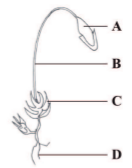
- Name the parts labeled B and D. (2 marks)
- State one function for each of the parts labelled A and C. (2 marks)
- The diagram below represents a member of the kingdom Animalia.
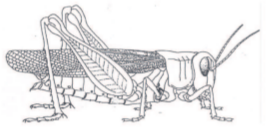
- Name the phylum to which the organism belongs. (1 mark)
- Using observable features in the diagram, give three reasons for the answer in b(i). (3 marks)
- The diagram below represents a plant in the division Bryophyta.
- The diagram below represents the human ear.
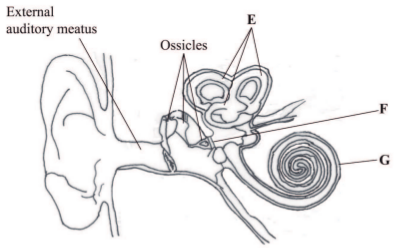
- Name the parts labelled E, F and G. (3 marks)
- How is each of the following adapted to its function?
- External auditory meatus; (2 marks)
- Ear ossicles. (2 marks)
- Name one defect of the human ear. (1 mark)
-
- Explain the importance of the following in photosynthesis: (3 marks)
- light;
- carbon(IV) oxide;
- chlorophyll.
- Name one appropriate food substance for each of the following enzymes: (2 marks)
- ptyalin ........................
- pepsin ......................
- State the cause and two symptoms of Beri-beri.
- Explain the importance of the following in photosynthesis: (3 marks)
- In an investigation, a variety of pea plants grown from seeds with smooth coats were crossed with plants grown from seeds with wrinkled coats. All the seeds obtained in the first filial (F1) generation had smooth seed coats.
- Using the letter R to represent the gene for smooth seed coat, work out the genotype of the F1 generation. Show your working. (3 marks)
- If the F1 generation was selfed, determine the phenotypic ratio of the second filial (F2) generation. Show your working. (3 marks)
- If the total number of seeds in the F2 generation was 14 640, calculate the number of seeds with wrinkled coats. Show your working. (2 marks)
- The diagram below represents a mammalian pelvic girdle.
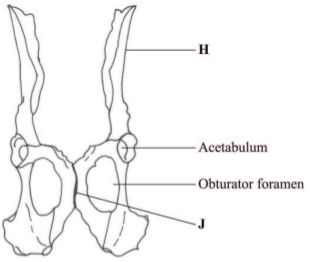
- How are the structures labeled H and J adapted to their function?
- Name the function of obturator foramen. (1 mark)
-
- Name the bone that articulates with the pelvic girdle at acetabulum. (1 mark)
- Name the type of joint formed by the acetabulum and the bone named in (c)(i) above. (1 mark)
- Name the bone formed by the fusion of caudal vertebrae in human beings. (1 mark)
SECTION B (40 marks)
Answer question 6 (compulsory) and either question 7 and 8 in the spaces provided after question 8.
- A scientist carried out an investigation to find out the population growth of mice under laboratory conditions. Twenty young mice were placed in a cage. The results obtained from the information were as shown in the table below.

- On the grid provided, draw a graph of the number of mice against time. (6 marks)
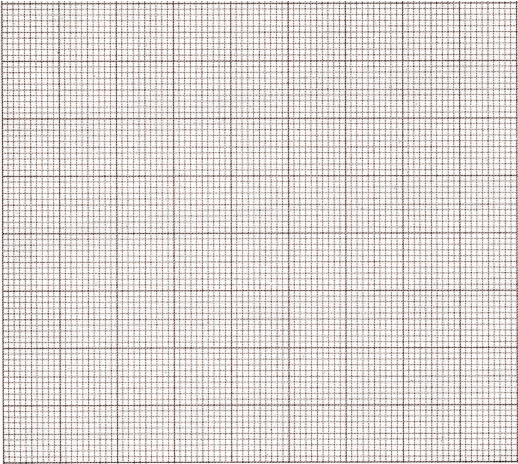
- Account for the changes in mice population between
- 0 to 2 months (2 marks)
- 2 to 6 months (2 marks)
- 6 to 10 months (2 marks)
- 10 to 12 months (2 marks)
-
- Between which two months was the population change greatest? (1 mark)
- Calculate the rate of population change over the period in (c)(i) above. (2 marks)
- What change in the population would be expected if the investigation was continued to the 19th month? (1 mark)
- To obtain the observed results, state two variables that were kept constant during the investigation. (2 marks)
- On the grid provided, draw a graph of the number of mice against time. (6 marks)
-
- Describe the process of blood clotting in human beings. (10 marks)
- How are respiratory surfaces in mammals adapted to their functions? (10 marks)
- Describe the role of the following organs in excretion and homeostasis.
- The liver (10 marks)
- The skin during hot environmental conditions. (10 marks)

MARKING SCHEME
-
-
- B Seta/stalk; 1 mark
D Rhizoid; 1 mark - A Production of spores/sporulation; 1 mark
C Photosynthesis; 1 mark
- B Seta/stalk; 1 mark
-
- Arthropoda; 1 mark
-
- Segmented body;
- Jointed appendages;
- Presence of exoskeleton 3 marks
-
-
- E Semi circular canals;
F Oval window/Fenestra ovalis/Fenestra vestibuli;
G Cochlea; 3 marks -
- Lined with hair/secretion of wax/(has glands that secrete wax) to trap foreign
bodies;
Hollow/tubular/tube; to direct sound waves to the ear drum/tympanum/tympanic
membrane; (max) (2 marks - Small/form a lever system/solid; to amplify (sound) vibrations; (2 marks)
- Lined with hair/secretion of wax/(has glands that secrete wax) to trap foreign
- Deafness/ absence of pinna/ vertigo/tinnitus; (max) (1 mark
- E Semi circular canals;
-
-
- Provides energy needed to split water molecules into oxygen and hydrogen/ photolysis;
Provides energy for formation of ATP molecules (which is used in dark stage) (1 mark) - Combines with hydrogen ions to make glucose; (1 mark)
- Used to trap light energy; (1 mark)
- Provides energy needed to split water molecules into oxygen and hydrogen/ photolysis;
-
- Starch;
- Protein; (2 marks)
-
- Lack of vitamin B1/thiamine; (1 mark)
- Stunted growth;
- Paralysis of legs/arms/limbs/damage to peripheral nerves;
- Heart failure
- Swelling of feet/oedema
- Gastrointestinal disturbances/loss of appetite/sonstipation/diarrhoea/vomiting;
- Weight loss/muscle wasting
- Pale skin (2 marks)
-
-
-

-

- Genotypic ratio 1 : 2 : 1 ;(1 mark)
- Phenotypic ratio 3 smooth coats : 1 wrinkled coat; (1 mark)
- The total number of wrinkled seeds.
1/4 x 14,640 = 3660 ; (2 marks)
-
-
-
- H
- It is long/wide/broad/flat; to provide a large surface area for attachment of muscles;
- Has facets; for articulation with sacrum; (2 marks)
- J Has flexible cartilage; which allows for widening of the (female) pelvic girdle when giving birth/to absorb shock. (2 marks)
- H
- Allows passage of blood vessels/nerves/ and muscles; (1 mark)
-
- Femur; 1 mark
- Ball and socket; 1 mark
- Coccyx; 1 mark
-
-
- See graph on page 5.
-
- No change in population/population is constant; mice still maturing/have not given birth; (2 marks)
- Slow/gradual population growth; few mice have reached sexual maturity; (2 marks)
- Faster/rapid rate of population growth/exponential;
Many mice sexually matured/reproducing/enough food/space/no competition/ birth rate higher than death/no diseases: (2 marks) - Population decline;
Competition is high / food is limiting / space is limiting/accumulation of toxic
waste/disease (outbreak) deathrate higher than birth rate. (2 marks)
-
- 6 and 8 ; (1 mark)
- 310 - 115 = 195 mice per month;(2 marks)
- Population would increase; (1 marks)
- Food; space ; cage size; water; (max) (2 marks)

-
- When a blood vessel is cut/injured platelets/thrombocytes/damaged tissue/wound is exposed to the air; they release thrombokinase/thromboplastin ; an enzyme that activates the conversion of prothrombin; to thrombin; in the presence of calcium ions;
vitamin K/ phylloquinone ; is needed for the formation of prothrombin;
Thrombin converts (soluble blood protein) fibrinogen ; into (the fibrous form) fibrin;
which forms a mesh / network across the wound; The clot so formed prevents excessive bleeding; and entry of disease agents/pathogens/micro-organisms/microbes; Max 10 marks - Many to provide a large surface area; across which large amounts of gases diffuse;
moist surfaces; to dissolve respiratory gases; so as to diffuse.Made of a thin membrane/epithelium/one cell thick wall ; to reduce diffusion distance;
Highly vascularized; to carry away oxygen; and bring in carbon (IV) oxide; creating a steep diffusion gradients. (10 marks)
- When a blood vessel is cut/injured platelets/thrombocytes/damaged tissue/wound is exposed to the air; they release thrombokinase/thromboplastin ; an enzyme that activates the conversion of prothrombin; to thrombin; in the presence of calcium ions;
-
- Regulation of blood sugar ; when blood sugar is below normal/90 mg/100 cm3 glucagon ; triggers the conversion of glycogen to glucose in the liver ; the glucose is released into the blood stream. When blood sugar is in excess above normal/10 mg/100 cm3, insulin; causes the liver to convert glucose excess to glycogen ; which is stored.
Production of heat energy ; by increasing the rate of metabolic activities;
Excretion of bile pigments ; produced due to breakdown of worn out red blood cells;
Deamination/removal of amino group of excess amino acids to form urea; and detoxication/poisonous/toxic substances;(Max 10 marks) - Sweat glands excrete urea; excess water; and salts; hence maintaining salt & water balance in the blood. Evaporation of sweat; cools the body due to loss of latent heat of vaporization; when the body temperature rises ; blood vessels in the skin vasolidate;
allowing more blood to flow near the skin surface; thus heat is lost to the environment by radiation/convection. The erctor pili mucle relaxes hair flattens ; in a hot environment reducing insulation; hence heat is lost from the body by radiation/ convection; to the environment.
- Regulation of blood sugar ; when blood sugar is below normal/90 mg/100 cm3 glucagon ; triggers the conversion of glycogen to glucose in the liver ; the glucose is released into the blood stream. When blood sugar is in excess above normal/10 mg/100 cm3, insulin; causes the liver to convert glucose excess to glycogen ; which is stored.
Download Kenya Certificate Of Secondary Education(KCSE 2013) Biology Paper 2 with Marking Scheme.
Tap Here to Download for 50/-
Get on WhatsApp for 50/-
Why download?
- ✔ To read offline at any time.
- ✔ To Print at your convenience
- ✔ Share Easily with Friends / Students

